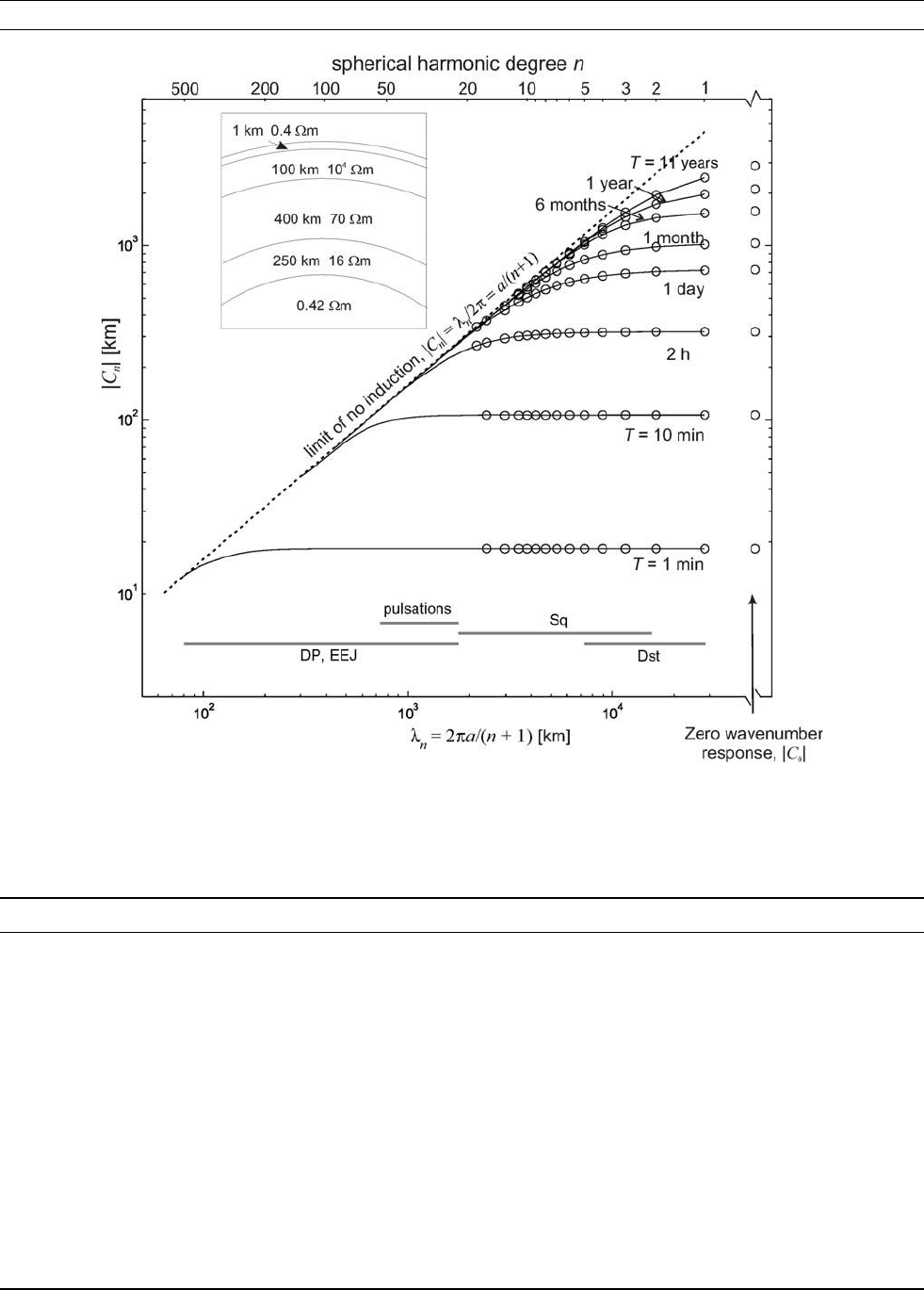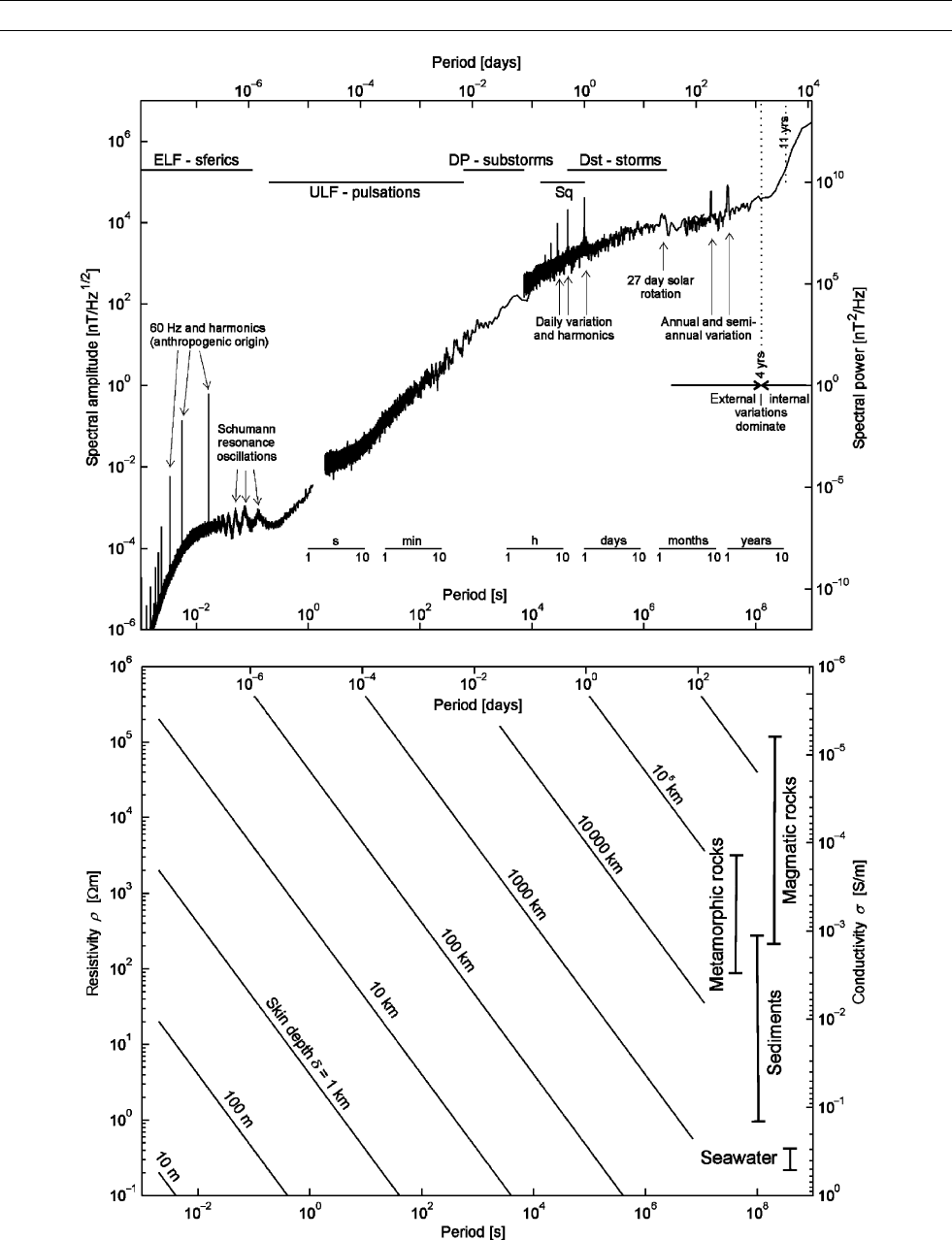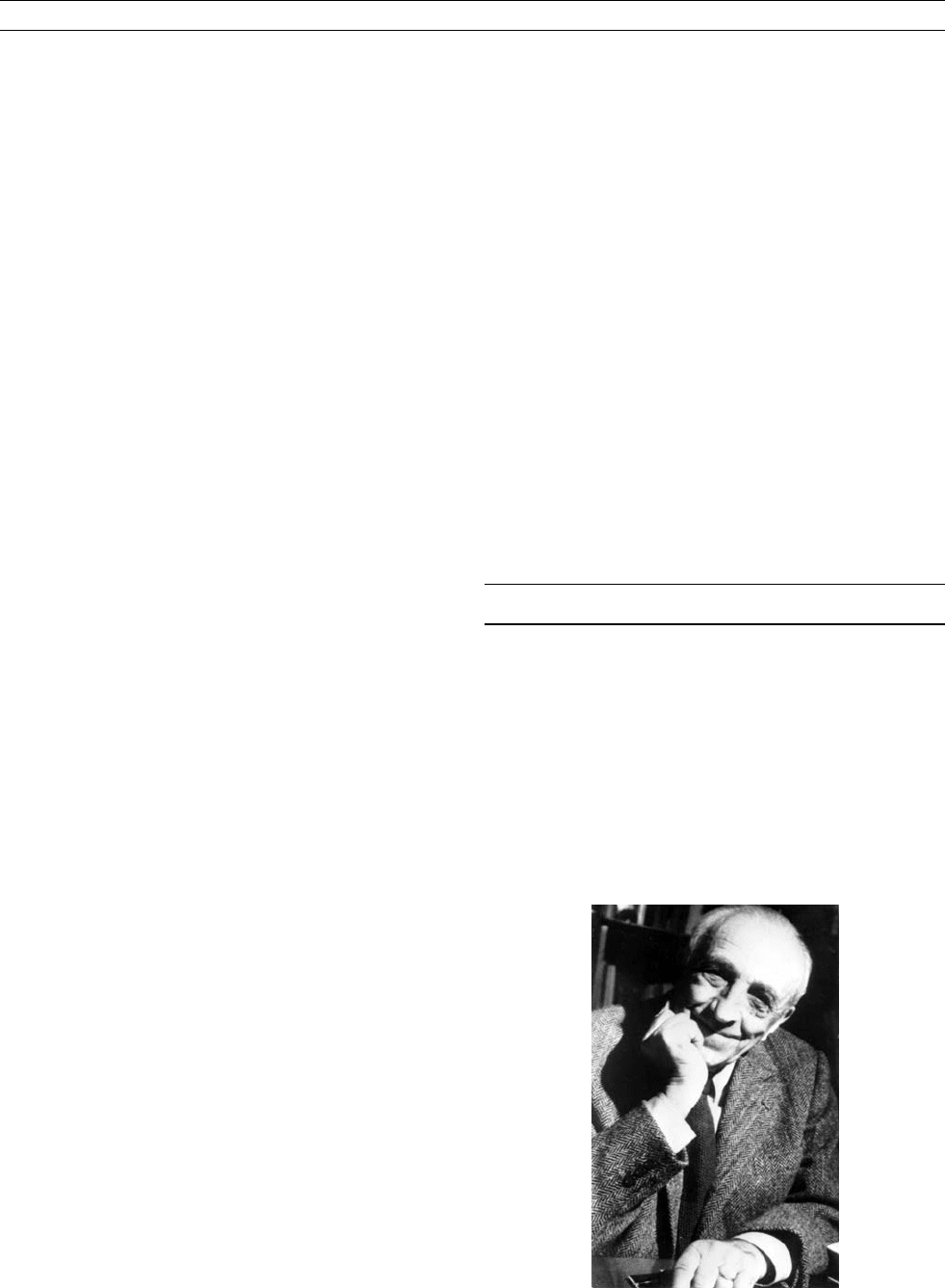Gubbins D., Herrero-Bervera E. Encyclopedia of Geomagnetism and Paleomagnetism
Подождите немного. Документ загружается.


N
NAGATA, TAKESI (1913–1991)
Born in Aichi Prefecture, Japan; graduated from the Physics Depart-
ment, University of Tokyo, 1936; research associate, Earthquake
Research Institute, University of Tokyo, 1937; associate professor,
1941 and professor in the Department of Geophysics, University of
Tokyo, 1952–1974; director of the National Polar Research Institute,
1973–1984; adjunct professor of University of Pittsburgh, 1962–1977;
Nagata was quite active in international cooperation and served as
bureau member of the International Union of Geodesy and Geophy-
sics (IUGG) for 1960–1963, president of the International Associa-
tion of Geomagnetism and Aeronomy (IAGA) for 1967–1971, and
vice-president of the Scientific Committee on Antarctic Research
(SCAR) for 1972–1976.
His doctoral thesis was devoted to a systematic experimental study
of the properties of the thermoremanent magnetization (TRM) in vol-
canic rocks (Nagata, 1943). This included, concurrent with the work
of Emile Thellier in France, the discovery of proportionality of the
TRM to the magnetizing field and additivity of partial TRM. In
1951, Nagata and his colleague, and students Syun-iti Akimoto and
Seiya Uyeda made a great sensation in geophysics community, by
the discovery of the self-reversal of the TRM in Haruna dacite. The
field reversal vs self-reversal continued to be a topic of hot controversy
through 1950s and 1960s until Allan Cox and others established
the polarity reversal timescale. Nagata and his colleagues studied not
only the TRM, but also various forms of remanent magnetization,
which are found in nature as well as are produced in the laboratory.
These included viscous remanent magnetization (VRM, with Yoshio
Shimuzu), chemical remanent magnetization (CRM, with Kazuo
Kobayashi), pressure-induced remanent magnetization (PRM, with
Hajimu Kinoshita), and shock remanent magnetization (SRM). The
textbook Rock Magnetism, which was first published in 1953 and then
revised in 1961, summarized all these works in rock magnetism, and
was very influential to the community till very recent times.
Nagata also took part in studying the magnetic properties of the
lunar rocks collected by the Apollo project and meteorites of various
types. Nagata’s scientific interest covered all the aspects of geomag-
netism and the newly developing space sciences. Besides rock magnet-
ism and paleomagnetism, he studied the main magnetic field, secular
variation, tectonomagnetic effects, ionosphere, magnetic storms, and
aurorae. Nagata became a very famous scientist in Japan and was influ-
ential in Japanese scientific policy on developing the polar exploration,
rocket and satellite experiments, and even on the earthquake prediction
program. His popularity arose mostly because he was the leader of the
Antarctic expeditions for three consecutive years (1956–1958). This
project was started as a part of the Japanese contribution to the Inter-
national Geophysical Year Program (1957). The expedition built the
Syowa Base on the Ongul Island in Antarctica and started various
scientific observations, which are continued to this day. One of the
prominent achievements of these expeditions was the discovery of
meteorites on the ice field in 1969. Nagata strongly promoted contin-
ued search in the following years, and more than 16000 meteorites
were recovered from the Antarctic ice surfaces since then. For the
scientific achievement and for public services, he was elected to Mem-
ber of Japan Academy (1983), and was awarded the Japan Academy
Prize (1951), the Order of Culture of Japan (1974), and the gold medal
of the Royal Astronomical Society, UK (1984).
Masaru Kono
Bibliography
Nagata, T., 1943. The natural remanent magnetism of volcanic rocks
and its relation to geomagnetic phenomena. Bulletin of Earthquake
Research Institute, 21:1–196.
Nagata, T., Akimoto, S., and Uyeda, S., 1951. Reverse thermo-
remanent magnetism. Proceedings of the Japan Academy, 27:
643–645.
Nagata, T., 1961. Rock Magnetism, revised edition. Tokyo: Maruzen,
350 pp.
NATURAL SOURCES FOR ELECTROMAGNETIC
INDUCTION STUDIES
Time changes of the magnetic field, regardless whether they are of
internal (core) or of external (in the atmosphere, ionosphere, and mag-
netosphere) origin, produce secondary currents in the Earth’s interior.
Observations of the superposition of the primary (inducing) and sec-
ondary (induced) electromagnetic field allows for a determination of
the electrical conductivity of the Earth’s interior.
Mantle conductivity can be probed “from below” using signals ori-
ginating from the outer core. This method requires a precise determi-
nation of the field during rapid and isolated events, like geomagnetic
jerks (q.v.), and some a priori assumptions about the kinematics
of the fluid motion at the top of the core. Conductivity of mantle
and crust can also be studied “from above” by the analysis of field

changes of external origin, as the induced currents of these fluctuations
modify the observed electromagnetic field. Both methods require
good knowledge of the time-space structure of the inducing field.
The first approach has its strength in estimating the conductivity of the
deep mantle, whereas the second approach is suitable for probing
the conductivity of the crust and upper mantle down to the depths
of 1000 km or so. This article summarizes natural sources of external
origin only.
Two approaches are in use: the Geomagnetic Deep Sounding (q.v.)
(GDS) method utilizes time changes of the vertical and horizontal
magnetic field components; whereas Magnetotellurics (q.v.) (MT) uses
the horizontal components of magnetic and electric fields. GDS is used
for global soundings and with natural sources in the period range
between hours and years, whereas MT is mostly used for regional stu-
dies and with periods between milliseconds and a few hours due to the
decrease of the electric field strength with decreasing frequency.
Natural geomagnetic variations in the period range between a few
hours and a couple of days have been used for more than one century
to infer the electrical conductivity of the Earth’s mantle in the depth
range of a few hundred kilometers. The dominant sources for these
variations are the magnetospheric ring-current and the ionospheric cur-
rent system generated by wind systems in the upper atmosphere. The
latter produces periodic external field variations (periods of 24 h and
harmonics), whereas the magnetospheric ring-current contributes to
field variations in the whole period range between minutes and months.
These two sources are still the most important ones for inferring mantle
conductivity in the depth range of a few hundred kilometers.
Time-space structure of external sources
At the Earth’s surface, temporal variations of the magnetic field of
external origin, B
ext
¼rV
ext
, can be described by means of a scalar
potential V
ext
. For modeling its spatial dependency, the flat-Earth
approximation may be used to study phenomena that have a spatial
scale much smaller than the Earth ’s radius. Studying phenomena at
longer scales requires a spherical approach in which V
ext
is expanded
in a series of spherical harmonics (q.v.)
V
ext
t; r; y; fðÞ¼a
X
N
n¼1
X
n
m¼0
q
m
n
tðÞcos f þ s
m
n
tðÞsin f
r
a
n
P
m
n
cos yðÞ
¼ aRe
X
N
n¼1
X
n
m¼0
e
m
n
tðÞ
r
a
n
P
m
n
cos yðÞexp imf
()
(Eq. 1)
where ðr; y; fÞ are radius, colatitude, and longitude of a spherical
coordinate system, respectively, with a as the Earth’s radius, P
m
n
as
the associated Legendre function of degree n and order m, and
e
m
n
¼ q
m
n
is
m
n
as the corresponding external expansion coefficients.
A similar expansion holds for the internal (induced) magnetic
field, B
int
¼rV
int
, with expansion coefficients i
m
n
and radial depen-
dence ða=rÞ
nþ1
instead of ðr=aÞ
n
. The horizontal scale-length of
a mode of degree n is l
n
¼ 2pa=ðn þ 1Þ40 000=ðn þ 1Þ km.
If conductivity depends only on depth (1D conductivity), each
expansion coefficient of the external field induces only one internal
coefficient of same degree n and order m, and the ratio of their Fourier
components (time dependence e
iot
), Q
n
ðoÞ¼i
m
n
ðoÞ
e
m
n
ðoÞ, depends
only on degree n.
Transfer functions (q.v.) like Q
n
or the C-response
C
n
¼
a
n þ 1
1 ½ðn þ 1Þ=nQ
n
1 þ Q
n
depend on the frequency o as well as on the spatial scale l
n
(i.e., sphe-
rical harmonic degree n) of the source field, and on the electrical con-
ductivity distribution. Dependence of the C-response on spatial scale
l
n
and period is shown in Figure N1 for a typical model of mantle con-
ductivity. The horizontal parts of the curves present the range of l
n
, for
which source effects (the dependence of C
n
on l
n
) are negligible and
C
n
converge to the zero wave number response C
0
. For the given con-
ductivity model, this is true for variations of period T < 1 min. In the
limit of no induction for which jC
n
j¼l
n
=2p, the response (and hence
the induced field) is determined by the geometry of the source rather
than Earth’s conductivity. Because jC
n
jl
n
=2p, the maximum depth
for which conductivity can be determined is given by the spatial scale
l
n
of the source; with the chosen conductivity model it is for instance
not possible to probe the Earth’s conductivity using measurements of
the equatorial electrojet (EEJ) for periods >2h.
GDS requires a precise description of the time-space structure of
the potential V
ext
of the external field, but knowledge of the location
of the external sources (currents) is not required—provided they are
external to a sphere including the observation point (i.e., external to
Earth for ground observations). This means that the determination of
the equivalent source is sufficient for induction studies. The following
section focuses on the morphology rather than on the physical nature
of the various geomagnetic variations that are used for EM induction
studies.
Classification of geomagnetic variations
Table N1 presents a classification of magnetic variations in depen-
dence on period and Figure N2 shows a typical spectrum of the north
component of the geomagnetic field for a midlatitude site.
Magnetospheric ring-current
The ring current (q.v.) in the magnetosphere (q.v.) is probably the
source that has been used for most studies of mantle conductivity. To
first approximation, its spatial structure can be described by the single
spherical harmonic P
0
1
ðcos y
d
Þ , where y
d
is geomagnetic (dipole) cola-
titude. Hence only the expansion coefficient q
0
1
¼ e
0
1
of Eq. (1) is used.
Although the spatial structure of individual magnetic storms is often
more complicated and requires more coefficients, the validity of this
P
0
1
-assumption on average seems to be remarkably good, at least for
periods longer than a few days. For a P
0
1
source, and a 1D conductiv-
ity, only one internal coefficient, i
0
1
, is induced, and the sum of external
(inducing) and internal (induced) potential is
V ¼ V
ext
þ V
int
¼ e
0
1
þ i
0
1
r=aðÞ
3
hi
cos y
d
(Eq. 2)
This allows for a determination of the C-response from magnetic data
of an individual site from observations of B
r
¼e
0
1
þ 2i
0
1
cos y
d
and
B
y
¼ e
0
1
þ i
0
1
sin y
d
at that site (r ¼ a) according to
C
1
oðÞ¼
a tan y
d
2
B
r
oðÞ
B
y
oðÞ
(Eq. 3)
This approach, known as Z/H-method, has been used by most
researchers to infer mantle conductivity at a few hundred kilometer
depths with periods between few days and several months.
Daily variations
Periodic external field (q.v.) variations at nonpolar latitudes (Sq varia-
tions) are caused by diurnal wind systems in the upper atmosphere,
which produce electric currents in the E-layer of the ionosphere
(q.v.) between 100 and 130 km altitude. Typical peak-to-peak ampli-
tudes at midlatitudes are 20–50 nT; amplitudes during solar maximum
are about twice as large as those during solar minimum. Sq variations
are restricted to the sunlit (i.e., dayside) hemisphere, and thus depend
mainly on local time T ¼ t þ f (t and f are UT and longitude
expressed in radians). The external potential (see Eq. (1)) of such local
NATURAL SOURCES FOR ELECTROMAGNETIC INDUCTION STUDIES 697

Figure N1 Absolute value of the C-response for a typical conductivity model (shown in the inset) as a function of horizontal
scale-length l
n
and period T of the source.
Table N1 Classification of geomagnetic variations (after Schmucker 1985, modified), with typical periods, amplitudes, and penetration
depths
Type of variation Symbol Typical period Typical amplitude Typical penetration depth
Solar cycle variations 11 years 10–20 nT >2000 km
Annual variation 12 months 5 nT 1500–2000 km
Semiannual variation 6 months 5 nT
Storm-time variation Dst Hours to weeks 50–500 nT 300–1000 km
Regular daily variation
At midlatitudes Sq 24 h and harmonics 20–50 nT 300–600 km
At low latitudes EEJ 50–100 nT
Substorms DP 10 min to 2 h 100 nT (1000 nT at p.l.) 100–300 km
Pulsations (¼Ultra low
frequency waves)
ULF 0.2–600 s 20–100 km
regular pc 150–600 s (pc5) 10 nT (100 nT at p.l.)
continuous 45–150 s (pc4) 2 nT
pulsations 5–45 s (pc2,3) 0.5 nT
0.2–5 s (pc1) 0.1 nT
Irregular transient pulsations pi 1–150 s 1 nT
Extreme low-frequency waves ELF sferics 1/5–1/1000 s <0.1 nT Tens of meters-kilometers
Schumann resonance oscillations 1/8 s <0.1 nT
Very low-frequency waves, whistlers VLF 10
–5
–10
–3
s Few meters-tens of meters
Note: If amplitude depends significantly on latitude, values are also given for polar latitudes (p.l., dipole latitude >65
).
698 NATURAL SOURCES FOR ELECTROMAGNETIC INDUCTION STUDIES

Figure N2 Top: Amplitude of magnetic variations (north component) at a midlatitude site for periods between 1 ms and 30 years,
estimated using data from the sites Niemegk/Germany (2 h–30 years), Kakioka/Japan (2 s–2 h), and Socorro/USA (1 ms–1 s).
Bottom: Skin depth d ¼
ffiffiffiffiffiffiffiffiffiffiffiffiffiffiffiffi
rT=pm
0
p
for a uniform half-space in dependence on resistivity r and period T.
NATURAL SOURCES FOR ELECTROMAGNETIC INDUCTION STUDIES 699

time phenomena consists of elementary modes of the form
e
m
n
r=aðÞ
n
P
m
n
exp imT, with periods of 24/m h. Coefficients representing
most of the power are those with n ¼ m þ 1, i.e., e
1
2
; e
2
3
; :::: Typically,
four Fourier terms, m ¼ 1–4 (periods 24,...,8 h), are used, which
results in a somewhat restricted period range of a factor of four; there-
fore Sq variations provide conductivity estimates only in a rather
limited depth range between roughly 300 and 600 km. The earliest
attempts (Schuster, 1889; Chapman (q.v.), 1919) to determine mantle
conductivity have used Sq as the inducing source.
There is about a fivefold enhancement of the daily variation near the
dip-equator, called EEJ. Its latitudinal width is about 6
–8
, which
requires spherical harmonics up to degree n ¼ 20–30 or higher.
Seasonal and solar cycle variation
The amplitudes of Sq variations depend on the season and on the
11-year cycle of solar activity, but because of vanishing ionospheric
conductivity (due to vanishing solar radiation) ionospheric currents are
almost zero at night. This requires ionospheric currents that vary with
season and solar cycle (i.e., there exists a true long-period variation in
addition to a modulation of the daily variation). In addition, there is also
a pronounced seasonal (mainly semiannual) and solar cycle variation of
the magnetospheric ring current. Induction studies using semiannual,
annual, and 11-year signals provide information on the conductivity
of the lower mantle. However, reliable estimates of transfer functions
at such long periods are hampered by contamination by short-term
secular variation of the core field. The main spherical coefficients
are e
0
1
(semiannual, solar cycle variation) and e
0
2
(annual variation).
Magnetospheric substorms, DP variations
Magnetic storms and substorms (q.v.) are irregular variations caused
by the interaction of the Earth’s magnetic field with the solar wind.
Ionospheric currents in the auroral regions, called polar electrojets
(PEJ), are linked to the magnetosphere by field-aligned currents. Both
currents are highly dependent on solar wind conditions. Their mag-
netic field variation, called disturbed polar (DP) variation, has a typical
timescale of a few minutes to hours and a horizontal scale-length of a
few hundred kilometers.
Geomagnetic pulsations, ULF and ELF waves, sferics,
and whistlers
Geomagnetic pulsations (q.v.), i.e., ultralow-frequency (ULF) waves,
cover roughly the period range from fractions of a second to a few
minutes. On the basis of their waveform, pulsations are classified into
pulsations continuous (pc) and pulsations irregular (pi). Their ampli-
tudes range from 100 to 0.1 nT, with longer periods exhibiting larger
amplitudes. Typical amplitudes are 1 nT at midlatitudes and 10 nT at
polar latitudes for a period of 30 s. There are several mechanisms that
produce pulsations; resonant oscillation of the Earth’s main field in
response to changes in the solar wind is one of them. The typical spa-
tial size of pulsations at midlatitudes is a thousand kilometers and
longer.
Extremely low-frequency (ELF) waves covering periods from milli-
seconds to seconds originate from thunderstorm lightnings and are
called atmospherics of sferics. This part of the spectrum shows, in par-
ticular, Schumann resonance oscillations (with peaks at 8 Hz and mul-
tiples) caused by standing waves in the waveguide formed by the
Earth’s surface and the ionosphere. Whistlers are sferics that travel
along Earth’s magnetic field lines from one hemisphere to the other.
As higher frequencies travel faster than the lower ones the lightning
wave is dispersed into a whistler tone.
Nils Olsen
Bibliography
Chapman, S., 1919. The solar and lunar diurnal variations of terrestrial
magnetism. Philosophical Transactions of the Royal Society of
London, Series A, 218:1–118.
Schmucker, U., 1985. Sources of the geomagnetic field. Landolt-
Börnstein, Berlin-Heidelberg: Springer-Verlag. New-Series, 5/2b,
section 4.1.
Schuster, A., 1889. The diurnal variations of terrestrial magnetism.
Philosophical Transactions of the Royal Society of London, Series A,
180:467–518.
Cross-references
Chapman, Sydney (1888–1970)
Geomagnetic Deep Sounding
Geomagnetic Jerks
Geomagnetic Pulsations
Harmonics, Spherical
Ionosphere
Magnetosphere of the Earth
Magnetotellurics
Periodic External Fields
Ring Current
Storms and Substorms, Magnetic
Transfer Functions
NE
´
EL, LOUIS (1904–2000)
Louis Néel was born in Lyon, France. He followed the classic French
academic path to excellence: starting from the “classes préparatoires
Maths Sup” of Lycée du Parc in Lyon, he joined the Ecole Normale
Supérieure de Paris and later obtained the “Agrégation de Physique.”
His early vocation for magnetism led him to defend a thesis under
the supervision of Pierre Weiss in 1932 in Strasbourg, where he set
up the theoretical basis that grounded his later discovery of antiferro-
magnetism (Néel, 1936; the term antiferromagnetism was later coined
by Bitter). Mainly, his input was to introduce the concepts of quantum
mechanics in magnetism (following Heisenberg exchange interaction
concept), turning the uniform molecular field of Pierre Weiss into a
local field. He became professor in Strasbourg in 1937 and gained
Figure N3 Louis Ne
´
el (1904–2000).
700 NE
´
EL, LOUIS (1904–2000)

international recognition soon after. During World War II, he moved to
Grenoble where he spent the rest of his career. His central contribution
to modern magnetism was quite lately acknowledged by a Nobel Prize,
shared in 1970 with Hannes Halfven. Both of them, top physicists,
have grounded a discipline of geophysics: rock magnetism for the for-
mer, magnetospheric and space plasma physics for the latter. One can
appreciate his place in modern magnetism knowing that his scientific
contributions are at the origin or central to the understanding of anti-
ferromagnetism, ferrimagnetism, fine-grained magnetism, thermore-
manence, viscosity theory in single- and multidomains, theories of
the Rayleigh law and hysteresis cycle, domain walls, exchange and
surface anisotropies, coupling interaction and self-reversal, for the
most notable. To get a more detailed account of his scientific contri-
butions one can refer to his Nobel lecture (Néel, 1970) as well as to
Prévot and Dunlop (2001).
Closer to our concerns, Louis Néel gained interest in paleomagnet-
ism very early mostly through its rapid passage as the director of
Clermont-Ferrand Geophysical Observatory in 1931 (30 years after
B. Brunhes). At that time the nature of natural remanent magnetization
(NRM) was a full mystery and this may have triggered a good part of
Louis Néel theoretical breakthroughs. His most prized contribution in
rock magnetism concerns the single domain theory of relaxation time,
thermoremanence, and viscous remanence (Néel, 1949). This theory
turned paleomagnetism from magic to science. In the original paper
the theory was validated using the experimental results of Thellier on
baked clays, going against the often-observed reluctance of physicists
to use natural samples as a valid model. Nicely, this rather exotic con-
tribution for a physicist nowadays is the most cited paper of Louis
Néel, mostly in the nongeophysics literature. This is a beautiful exam-
ple of the input of Earth sciences into physics, balancing the more
common backward input. On the other hand, Louis Néel and his cow-
orkers were able to synthesize and measure the highly anisotropic
magnetization of the predicted ordered form of Fe-Ni alloy (Néel
et al., 1964). As this ordering appears only below 320
C, that is, at
a temperature where atomic diffusion is negligible, they used a trick
to enhance this diffusion: neutron bombardment. Much later, another
trick was found—ultralow cooling rates—only available in meteorite
parent bodies; the Fe-Ni ordered phase, tetrataenite, was “redis-
covered” (e.g., Wasilewski, 1988).
A great lesson from Louis Néel’s career (Néel, 1991) is that while
being so sharp in his personal scientific work he was so broad in his
interests and inspiration. His hobby was woodwork. It would be a
large error to remember him mainly as a theoretician: he demonstrated
great skills as an experimentator and as a man of action and organiza-
tion. When the Nazi troops approached Strasbourg in 1939 he orga-
nized practically by himself the evacuation of the most sensitive
equipments of the Strasbourg University in a train convoy. Soon after
he was responsible for battleship demagnetization to avoid the trigger-
ing of magnetic mines moored at the entrance of French ports. It took
him less than 6 months to set up original ship-size demagnetization
systems in several major ports and efficiently “immunize” more than
500 ships. He was fully involved in practical and engineering magnet-
ism, for example through military research or through the push of
improving the magnetic materials used in recording or electromechani-
cal devices. When he arrived in Grenoble, there were a handful of phy-
sicists in the university. When he retired from his leading position
there 30 years after, thousands of people were involved in various fun-
damental and applied physics research institutes. As the leading
builder of this top European center for solid-state physics, he early
recognized that subdisciplines of theoretical and experimental physics
have to work in close connection to solve the complex problems facing
modern physics. As a result, it is nowhere else than in Grenoble, where
it is possible to walk with the same sample from a neutron reactor to a
synchrotron x-ray source via world record high-magnetic field facil-
ities, finding all possible types of magnetic, spectroscopic, and other
measuring devices in between. The Louis Néel scientific impetus is still
visible today in the strong contribution of Grenoble laboratories—first
of all, the Louis Néel laboratory: http://lab-neel.grenoble.cnrs.fr — to
the advanceme nt of magnetism (du Trémolet de Lacheisserie et al.,
2002). These textbooks include a foreword by Louis Néel, acknowled-
ging the fact that he was going on to actively participate in the science
community until the term of his tremendously filled life.
Pierre Rochette
Bibliography
Du Trémolet de Lacheisserie, E., Gignoux, D., and Schlenker, M.,
2002. Magnetism, (two volumes) I-Fundamentals, II-Applications.
Dordrecht: Kluwer, 507 and 517 pp.
Néel, L., 1936. Théorie du paramagnétisme constant application au
manganese. Comptes Rendus De I’Académie des Sciences Paris,
203: 304–306.
Néel, L., 1949. Théorie du traînage magnétique des ferromagnétiques
en grains fins avec applications aux terres cuites. Annales De Géo-
physique, 5:99–136.
Néel, L., 1970. Magnetism and the local molecular field, Nobel Prize
lecture. Available at: http://www.nobel.se/physics/laureates/1970/
Néel-lecture.html.
Néel, L., 1991. Un siècle de Physique. Paris: Odile Jacob, 365 pp.
Néel, L., Paulevé, J., Dautreppe, D., and Laugier, J., 1964. Magnetic
properties of an iron-nickel single crystal ordered by neutron bom-
bardment. Applied Physics, 35: 873–876.
Prévot, M., and Dunlop, D., 2001. Louis Néel: 40 years of magnetism.
Physics of the Earth and Planetary Interiors, 126:3–6.
Wasilewski, P., 1988. Magnetic characterization of the new mineral
tetrataenite and its contrast with isochemical taenite. Physics of
the Earth and Planetary Interiors, 52: 150–158.
NONDIPOLE FIELD
The nondipole (ND) field is that part of the internal geomagnetic field
remaining after the major geocentric dipole contribution has been
removed. It is distinct from the nonaxial-dipole (NAD) field for which
only the component of the geocentric dipole that is parallel to Earth’s
rotation axis is subtracted. Figure N4a/Plate 4a shows the strength of
the total scalar field at Earth’s surface, with the spatial variations
dominated by the dipole field, while in Figure N4b/Plate 4b the dipole
contribution has been subtracted to reveal the substantially more com-
plex nondipole field. Two source regions contribute to the ND field:
the dynamo in Earth’s core that is also responsible for the dipole part
of the geomagnetic field produces the largest part; the other source
is Earth’s lithosphere (see Crustal magnetic field). Nondipole field
contributions are significant, but contribute only a small fraction of the
average magnetic energy at the surface, as can be seen in Figure N5a,
which shows
~
B
l
~
B
l
r¼a
, the squared average value of the field
strength over the Earth’s surface, average radius r ¼ a, as a function of
spherical harmonic degree, l.Thisgeomagnetic spatial power spec-
trum (q.v.) falls off rapidly with increasing l (decreasing wavelength),
up to about degree 12, then flattens out and remains roughly constant
out to the shortest resolvable wavelengths. The ND field between degrees
2 and 11 is dominated by sources in Earth’s core, while above degree 15
the core contribution is overwhelmed by that from lithospheric magnetic
anomalies (see Magnetic anomalies, modeling; Magnetic anomalies,
long wavelength;andMagnetic anomalies, marine). Between degrees
11 and 15, it is difficult to isolate the primary source, although time var-
iations (Figure N5b) in the core part at these spatial scales will be better
characterized with new high-quality satellite data. Temporal variations
in the lithospheric field occur on geological timescales, but direct mea-
surements over the past few centuries will only sense changes in inducing
fields. These are very small at timescales of the order of a year or longer.
NONDIPOLE FIELD 701
- 2008 — 2025 «СтудМед»
